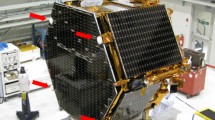Abstract
With the emergence of spaceborne geodetic receivers, GPS is rapidly invading the realm of Earth remote sensing. Among the current science applications are centimeterlevel precise orbit determination; gravity model improvement; high resolution ionospheric imaging; and atmospheric limb sounding to recover precise profiles of atmospheric density, pressure, temperature, and water vapor distribution. In the near future we may also see spaceborne GPS used for direct ocean altimetry and scatterometry. Almost uniquely among science sensors, GPS receivers lend themselves to incorporation into highly miniaturized, low cost, and fully autonomous sensorcraft.
Access this chapter
Tax calculation will be finalised at checkout
Purchases are for personal use only
Preview
Unable to display preview. Download preview PDF.
Similar content being viewed by others
References
Hajj GA and Romans LJ (1998) Ionospheric electron density profiles obtained with the Global Positioning System: Results from the GPS/MET experiment, Radio Sci, 33:175–190.
Hajj GA, Lee LC, Pi X, Romans LJ, Schreiner WS, Straus PR and Wang C (2000) COSMIC Ionospheric Sensing and Space Weather, to appear in Terrestrial, Atmospheric and Oceanic Sciences, March.
Kursinski ER, Hajj GA, Schofield JT, Linfield RP, Hardy KR (1997) Observing Earth’s atmosphere with radio occultation measurements using the Global Positioning System, J Geophys Res, 102 (D19), 23,429–23,465, Oct 20.
LaBrecque J, Lowe S, Young L, Caro E, Wu S, Romans LJ (1998) Recent Advances in the study of GPS Earth Surface Reflections from Orbiting Receivers, UNAVCO Community Meeting, Dec.
Lambeck K (1988), Geophysical Geodesy, Clarendon Press, Oxford.
Lemoine F, Pavlis N, Kenyon S, Rapp R, Pavlis E, and Chao B (1998) New high-resolution model developed for Earth’s gravitational field, EOS, Trans Am Geophys Union79, 113–118.
Lowe ST, LaBrecque JL, Zuffada C, Romans LJ, Young LE and Hajj GA (2000) First spaceborne observation of an earth-reflected GPS signal, submitted to J Geophys Res Jan.
Mannucci AJ, Wilson, Yuan, Ho, Lindqwister and Runge (1998) A global mapping technique for GPS-derived ionospheric total electron content measurements, Radio Sci 33(3), 565–583, 1998.
NASA (1991), Solid Earth Science in the 1990s; Volume 2—Panel Reports: NASA Tech Mem 4256, v 2, Washington, DC, 296 pp.
Rocken C, Anthes R, Exner M, Hunt D, Sokolovskiy S, Ware R, Gorbunov M, Schreiner W, Feng D, Herman B, Kuo YH and Zou X (1997) Analysis and validation of GPS/MET data in the neutral atmosphere. J Geophys Res 102 (D25), 29,849–29,866.
Schutz BE, Tapley BD, Abusali PAM and Rim HJ (1994) Dynamic orbit determination using GPS measurements from Topex/Poseidon, Geophys Res Lett, 21 (19), 2179–2182.
Wu SC, Meehan TK and Young LE (1997) The potential use of GPS signals as ocean altimetry observables, ION National Technical Meeting, Santa Monica, CA, Jan.
Yunck TP and Melbourne WG (1990) Geoscience from GPS tracking by Earth satellites, IAG General Meeting, Edinburg, 4–11 Aug 1989, reprinted in Global Positioning System: An Overview, Y Bock & N Leppard (eds), Springer-Verlag, 1990.
Yunck TP, Wu SC, Wu JT and Thornton CL (1990) Precise tracking of remote sensing satellites with the global positioning system, IEEE Trans Geosci & Remote Sensing, 28, pp 108–116.
Yunck TP (1996) Orbit Determination, in Global Positioning System—Theory and Applications, B Parkinson and J Spilker (eds), AIAA, Washington, DC, pp 559–592.
Author information
Authors and Affiliations
Editor information
Editors and Affiliations
Rights and permissions
Copyright information
© 2003 Springer-Verlag Berlin Heidelberg
About this chapter
Cite this chapter
Yunck, T.P. (2003). Spaceborne GPS for POD and Earth Science. In: Reigber, C., Lühr, H., Schwintzer, P. (eds) First CHAMP Mission Results for Gravity, Magnetic and Atmospheric Studies. Springer, Berlin, Heidelberg. https://doi.org/10.1007/978-3-540-38366-6_7
Download citation
DOI: https://doi.org/10.1007/978-3-540-38366-6_7
Publisher Name: Springer, Berlin, Heidelberg
Print ISBN: 978-3-642-53544-4
Online ISBN: 978-3-540-38366-6
eBook Packages: Springer Book Archive




